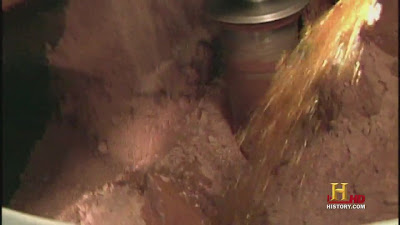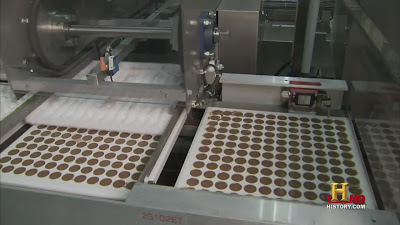







Coating Process.












Cocoa Bean.
Fermentation is the first process cocoa beans are subjected to in making chocolate. The process usually lasts up to seven days. Fermentation takes place in the pectinaceous pulp surrounding beans of this tree. Biochemical and enzymatic reactions that take place inside the cotyledon cause a variety of flavor compounds. The pulp surrounding the cocoa beans is fermented by various microbes including yeasts, lactic acid bacteria, and acetic acid bacteria. The resulting high temperature and products produced by these microbes, such as the ethanol from yeast, kill the beans and contribute to the flavoring of the chocolate.
Once the seeds are harvested, fermentation is usually begun immediately. The beans inside of the cocoa pods are in an environment such that no microbes can grow. However, upon cutting the cocoa pods open, the beans are exposed to microbes and the fermentation process is allowed to begin. Microbes arise from hands of workers, knives, unwashed baskets, and dried mucilage on fermentation boxes.
Containers wrapped in banana leaves are used to ferment up to 2000 kg of beans. The beans are covered in a white-cream, mucilaginous (protein/sugar coat) pulp that is solubilized, and the breakdown of the glue between the pulp cells walls and the cocoa honey (“sweatings”) are released through holes in the box containing the beans.
In the early stages of the fermenting process, yeasts produce ethanol and secrete enzymes that break down pectin. Bacteria (lactic acid and acetic acid bacteria) then appear, followed by aerobic spore-forming bacteria and filamentous fungi.
For more information : Chocolate MicrobeWiki

Ready to ship out.


jungle region.


Remove the shell.

Chocolate Liquor.
It is produced from cocoa beans that have been fermented, dried, roasted, and separated from their skins. The beans are ground into cocoa mass (cocoa paste). The mass is melted to become the liquor, and the liquor is cooled and molded into blocks known as unsweetened baking chocolate (bitter chocolate). From Wikipedia.
Chocolate Liquor, also known as ‘cocoa liquor’ and ‘cocoa mass’ is a smooth, thick, liquid form of chocolate. It is the purest form of chocolate, produced by grinding cacao beans. Chocolate liquor contains roughly 50% cocoa solids (cocoa powder) and 50% cocoa butter, the pale-yellow vegetable fat of the cacao bean. When it is cooled and molded into blocks, chocolate liquor is known as unsweetened baking chocolate.
Chocolate Liquor is the key ingredient in chocolate. It is used as the base for cakes, brownies, cookies and candy bars. Chocolate in its most familiar form is made by mixing chocolate liquor with (more) cocoa butter or cocoa, sugar, soy lecithin and, often, milk. The cocoa to cocoa butter ratio determines the darkness and flavor intensity of the chocolate being produced. As with dark chocolate, the higher the cocoa content, the darker and richer the flavor. The higher the cocoa butter and milk content, the lighter the color and creamier the texture of the resulting chocolate. A prime example of a chocolate with a high cocoa butter and milk content is white chocolate. White chocolate contains no cocoa.
HOW IS IT MADE? Chocolate Liquor is produced by taking cocoa beans that have been fermented, dried, roasted, and separated from their shells. The fermentation process is to remove the fleshy, fruity pulp that surrounds the beans; the fatty beans, themselves, do not ferment. Grinding the processed beans releases the smooth, thick chocolate liquor from their centers. Cocoa should not be confused with the coca plant, which can be used to create cocaine.








of the chocolate liquor.

Cocoa powder.








































Rotational Molding.
Rotational molding is ideally suited to the formation of very large, seamless, and stress-free
hollow parts such as agricultural tanks, although the process has also been used to make
parts as small as ping-pong balls. In this bunny chocolate case, they use the same principle to
make.The rotational molding process uses no pressure and so the molds can be simple and
inexpensive. Most processes that use no pressure are called casting or cast molding.
The rotational molding process has four principle steps : (1) loading, (2) heating, (3) cooling,
(4) unloading.
Refer to : PlastAAAAAAAKFk/yXcTBKzAvR4/s400/Chocolate28.JPG" width="400" />











No comments:
Post a Comment